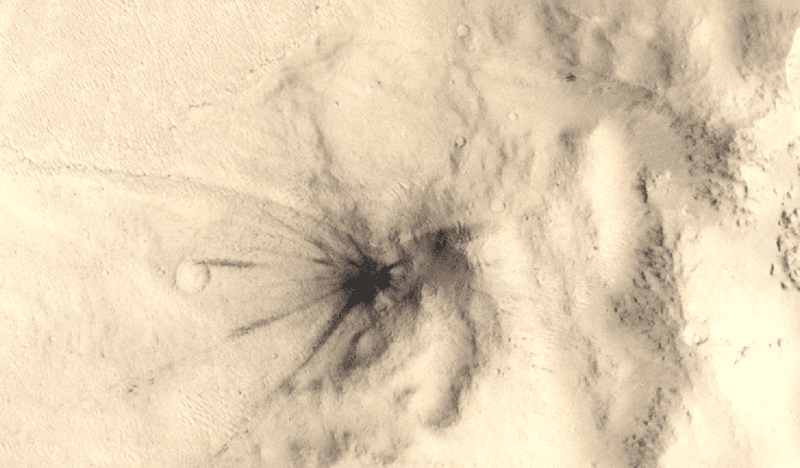- Mars has more meteor impacts than Earth. It’s closer to the asteroid belt and has a thinner atmosphere, so more space debris reaches its surface.
- Astronomers used Artificial Intelligence to help identify thousands of impacts near NASA’s InSight lander, which has been recording seismic activity on Mars since 2018.
- They established a connection between meteor impacts and marsquakes, and discovered that seismic waves from an impact can follow a “seismic highway” to reach deeper and faster into the planet than expected.
The European Space Agency published this original story on February 3, 2025. Edits by EarthSky.
Meteor impacts can cause Marsquakes
Marsquakes – the earthquakes of Mars – are common on our neighboring planet. And so are meteor impacts. On February 3, 2025, the European Space Agency said they’ve linked seismic activity from meteor impacts with Marsquakes. In the last two decades, scientists have manually identified hundreds of new impact craters across the Martian surface. But now artificial intelligence is saving researchers from the tedious detective work. It can more efficiently make connections between data collected by five different instruments orbiting the red planet.
The scientists published two new papers on their research, both in the peer-reviewed journal Geophysical Research Letters on February 3, 2025. Lead author of one of the studies, Constantinos Charalambous of Imperial College London, said:
This freshly mined data is exciting because it reveals that meteoroid impacts on Mars occur about twice as often as previous orbital image surveys estimated.
We used to think the energy from most seismic events detected by InSight was trapped traveling in the Martian crust. Now, we understand that seismic waves from some impacts can follow a deeper, faster path — call it a seismic highway — through the crust and deep into the mantle, allowing quakes to reach more distant regions of the planet.
These results show meteors strike the red planet 2 1/2 times more often than expected. So ESA’s space safety program is actively working to develop a planetary defense capability to mitigate and prevent the impacts of hazards from space.
The 2025 EarthSky lunar calendar makes a great gift. Get yours today!
Quakes on Mars can reach into the mantle
The new studies suggested quite a few of the seismic events recorded by InSight – previously thought originate from tectonic sources – could be from meteor strikes. This new impact crater (in false color, above) lies in Cerberus Fossae, a seismically active region. The 71-foot-diameter (21.5 meter) crater provided a definitive source location that was nearly twice as far away from InSight as scientists would have thought, based on the quake’s seismic energy. This could only be explained by the seismic energy taking a more direct route through the planet’s mantle.
Using AI, the researchers can sift through tens of thousands of images to find new impacts in hours. It would take years for a human to do the same task.
Matching the craters and the quakes help researchers refine their understanding of seismic signals on Mars. And it shows them how different types of vibrations travel through the planet at different depths and speeds.
Using data from various sources
The spacecraft continue to image Mars and send back data. Co-author Tom Pike from Imperial College said:
These results show the power of looking deeply into multiple datasets from Mars. Without the seismic data, we would not have known where to look for an impact in the orbital images, and without the orbital images, we would not have been able to locate the source of the seismic energy we detected with InSight.
The fact that we have been able to identify an impact in a single pixel of MRO’s low-res orbital camera, intended for daily weather monitoring, shows just how essential it is to combine these large datasets. The power and speed of AI means we have been able to find the proverbial needle in the haystack!
Bottom line: Astronomers have used AI to establish a link between meteor impacts on Mars and marsquakes. They found that seismic waves can travel faster through the planet than expected.
Source: New Impacts on Mars: Systematic Identification and Association With InSight Seismic Events
Read more: Are methane-belching microbes on Mars hiding underground?
Read our previous article: How snowflakes get their distinct and various shapes
